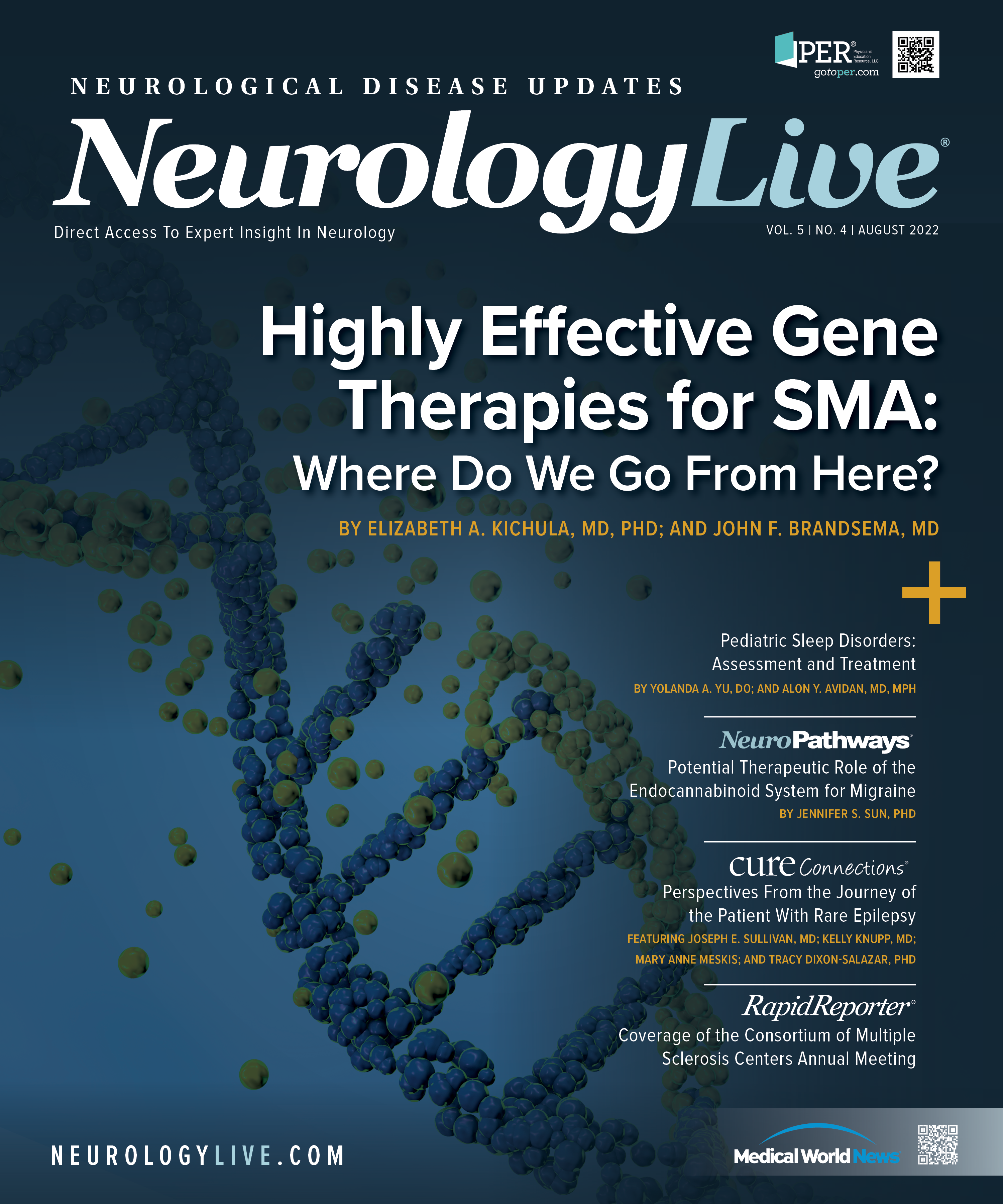Publication
Article
NeurologyLive
Highly Effective Gene Therapies for SMA: Where Do We Go From Here?
Neuromuscular medicine has entered an era of genetic therapy, opening the doors to questions about possible combination approaches and earlier initiation of treatment.
Elizabeth A. Kichula, MD, PhD

SPINAL MUSCULAR ATROPHY (SMA) has traditionally been one of the most devastating diagnoses to give within a pediatric neurology clinic. The advent of genetically targeted therapies, as well as the rapid expansion of newborn screening in the United States, has dramatically altered the natural history of the disease. A consistent theme emerging from experience thus far in the targeted treatment age is the importance of early diagnosis and intervention, as a more modest response to treatment is seen in those with longer disease duration and more severe symptoms at time of treatment initiation. Ongoing efforts to understand optimal treatment type and timing necessarily include the concept of combination therapies, although there is a paucity of evidence at this time regarding whether such an approach is superior to monotherapy.
SMA is caused by autosomal recessive mutations in the SMN1 gene. Approximately 95% of cases are caused by biallelic deletion of SMN1, whereas the remaining cases have at least 1 allele with another type of mutation, most commonly a point mutation, causing SMN1 to be nonfunctional. SMN2 remains active in those with SMA but produces insufficient amounts of survival motor neuron (SMN) protein compared with those produced by SMN1 because of a point mutation in SMN2 that leads to aberrant splicing. Insufficient amounts of SMN protein result in progressive motor neuron death, causing the main symptoms of SMA with progressive weakness, in addition to the lower motor neuron signs of areflexia and fasciculations. In the more severe forms of SMA, bulbar and respiratory weakness also occurs. SMN has multiple roles in various tissues of the body, and the exact mechanism that causes disease is still being studied.1
SMA classically presents as a range of phenotypes, with type 1 being the most common, accounting for about two-thirds of all diagnoses. Untreated, babies never attain the ability to sit, and need respiratory support by the age of 2 years. Children with type 2 never attain the ability to walk without treatment, whereas those with type 3 typically lose the ability to walk, either later in childhood or into adulthood. SMN2 copy number does not absolutely determine type, but it is the most critical factor: More copies of SMN2 typically lead to milder forms of disease as the amount of functional SMN protein increases. In general, those with infantile onset have only 2 copies whereas those with onset in later childhood more commonly have 3 to 4 copies,1 although exceptions to this correlation do occur.
John F. Brandsema, MD

Current Treatment Options
There are 3 treatment options that target the root cause of SMA by increasing the amount of SMN protein (TABLE). Nusinersen (Spinraza; Biogen) and risdiplam (Evrysdi; Genentech) work by altering the splicing of SMN2 to increase the amount of functional SMN protein. Nusinersen is an antisense oligonucleotide that is given intrathecally, initially as 4 loading doses over 2 months and then every 4 months as maintenance. Risdiplam is a small molecule that similarly modulates SMN2 translation to increase intact SMN; it is given as an oral solution daily. Both SMN2 modulators are currently approved for all individuals with SMA, regardless of age or type. Onasemnogene abeparvovec-xioi (Zolgensma; Novartis Gene Therapies) is an in vivo gene therapy. It is an AAV9 vector containing a plasmid with SMN DNA. The vector infects cells, with a tropism that includes motor neurons, leaving the plasmid to continuously produce SMN protein. SMA has been an ideal target for early experience with gene transfer as it is a disease of protein insufficiency, not absence, so there are fewer tolerability concerns regarding immunogenicity. Other advantages include the genetic homogeneity of the disease as well as the size of the SMN transgene, which is able to fit into the vector used. As motor neurons, the primary target cells, do not divide, the gene therapy should be long lasting, as current long-term follow-up from initial study patients suggests.2 Positive antibodies to AAV9 can at times preclude its use. The agent is currently approved in the United States as a one-time intravenous administration in children less than 2 years of age.
All treatments have shown profound benefits in infantile-onset SMA compared with the natural history of the disease.3-6 Further, additional data continue to be published for nusinersen7 and risdiplam,8 with emerging data about intrathecal delivery of gene transfer, showing some benefit in older individuals. Real-world data are important in understanding expectations of response to treatment in populations not studied in the original trials, including in adults with SMA.7 The improvements are not as dramatic; however, it is important to note that in a neurodegenerative disease, even stability is a benefit in comparison with the natural history of continued decline.

Importance of Early Diagnosis
Current therapies can help to increase SMN protein levels, which may help to rescue sick motor neurons and prevent future loss of these critical cells. Stabilization allows for collateral sprouting and reinnervation of the muscle. As motor neurons do not divide, there are no treatments at present that can replace lost motor neurons. In study after study, including those looking at a presymptomatic dosing of nusinersen, risdiplam, and onasemnogene,9-11 findings have shown the largest benefits from early treatment, leading to the addition of SMA to the Department of Health and Human Services’ Recommended Uniform Screening Panel in 2018. States in the US have worked to quickly add it to their newborn screening (NBS), and 97% of live births have screened for SMA as of mid-2022. NBS for SMA is a genetic test. It looks for the common deletion of SMN1; as such, it will miss about 5% of cases that are because of nondeletion mutations. If there remains concern for SMA despite normal NBS, testing should include both deletion assay as well as SMN1 sequencing.
Identification of SMA via NBS allows treatment to be started very early on in life, within the first 1 to 2 months. Results from clinical studies have shown that although many patients with 3 SMN2 copies treated presymptomatically will hit most major motor developmental milestones within typical windows, many infants with only 2 copies of SMN2 may go on to have some delays.9,11 This is heralded by what is seen clinically, where sometimes subtle decline in examination and symptoms can be seen over a short, 1- to 2-week period while treatment is being implemented.
Some states immediately report SMN2 copy number, whereas in other states it is not part of their NBS process. Confirming SMN2 copy number is important as it informs the urgency of treatment. Current recommendations12 are to treat all individuals with 2 to 4 copies of SMN2. Those with only 2 copies, or who have some signs of SMA on examination such as hypotonia, decreased reflexes, or subtle weakness, especially need to be urgently treated. Reflecting the “time is brain” mantra from the stroke literature, “time is motor neuron” in these cases. It is imperative that those who receive a diagnosis of SMA be seen quickly at sites that are familiar with the current treatments and are able to initiate treatment in a timely manner.
The importance of early treatment suggests a potential benefit to prenatal diagnosis via parental carrier testing, even in states with NBS. A prenatal diagnosis can include SMN2 copy number and allow the family more time to consider all treatments. Although the diagnosis is always inherently stressful, the result of positive NBS results in the immediate postnatal period, and the need to quickly decide on a treatment, can introduce additional stresses for the family. A prenatal diagnosis facilitates planning for pretreatment labs and genetic confirmation to be sent on the day of delivery, which may speed up this critical information by up to 2 to 3 weeks, further decreasing the time to treatment initiation. A prenatal diagnosis may also help to optimize the time of delivery, with consideration to induction at early term (ie, 38 or 39 weeks), although obstetric factors must also be carefully considered.
The potential to treat in utero is intriguing.13 Children can be symptomatic at birth, sometimes so significantly that infant cases are sometimes called SMA type 0, and more often with subtle findings of abnormal electrophysiology such as reduced compound muscle action potential amplitude or abnormal fasciculations on muscle ultrasound commonly seen at the first visit. There are currently no treatments that are available in utero. Gene therapy, as a one-time injection to the fetus, could be an option, but the safety of such administration remains unclear. Risdiplam can cross the placental barrier if administered to the mother; however, teratogenicity was identified preclinically10 and so risks/benefits and optimal timing of treatment in such situations again remain unclear.
Combination Therapy
One very active area of debate within the SMA community is the potential benefit (or lack thereof) of combination treatment. Most combination treatment at this time considers the combination of gene transfer with an SMN2 splice modifier. Onasemnogene does not result in the transduction of 100% of motor neurons in animal models, and so the additional SMN2 modulator may have some additional benefit. There are some data supporting the overall safety of gene transfer with risdiplam and/or nusinersen. Findings from some studies have suggested increased adverse effects from onasemnogene in patients who previously received nusinersen; however, those also tended to be older individuals and it is unclear whether age and/or nusinersen exposure may be more critical.14,15 Risdiplam may also have more systemic effects relative to the targeting of the central nervous system with intrathecal nusinersen delivery. It is very challenging to show whether there is additional benefit of a combination approach given the heterogeneity among the experience of individuals with SMA and what has been seen thus far in terms of variability in response to monotherapy. Even children who are treated with monotherapy commonly go through periods of relative plateau before having significant gains again. The RESPOND trial (NCT04488133) is an ongoing open-label study of infants and young children receiving nusinersen after gene transfer. The JEWELFISH study (NCT03032172) is an ongoing study of patients receiving risdiplam after a prior SMA treatment, a subgroup of whom received gene transfer before risdiplam initiation. The data from these trials will augment early real-world experience with combination therapy.16,17
Many individuals with SMA started on nusinersen after approval in late 2016 and then may have switched over to risdiplam once it became available in mid-2020 in the United States, and in some cases “switched back” to nusinersen as well. This is not true combination therapy as generally it is more of a transition between therapies. The ASCEND study (NCT05067790) is examining the impact of switching from risdiplam to higher-dose nusinersen.
Limited preclinical data exist on the potential benefit of using both SMN2 modifiers at once. There are no research trials currently studying this combination, although some participants in the SHINE extension study (NCT02594124) of nusinersen did receive combination treatment with commercial risdiplam after its approval. The majority of American health care plans limit patients to only 1 of these medications at this time.
Optimal timing of treatment(s) initiation may not be the same for every individual with SMA. Potential for toxicities with high levels of SMN expression, as recently described in mouse models,18 is another factor to consider. When 2 therapies are given close together, the potential interactions and adverse effects may be harder to separate. However, there is reason to think that earlier on in the disease may be the most effective time for combination treatment, particularly in symptomatic infants who would be predicted to manifest SMA type 1 or type 2 without treatment.
SMN-Independent Treatments
More recent trials have focused on alternative medications and treatments that may work in tandem with SMN replacement therapies, as well as in isolation, to further improve muscle strength. The most advanced of these is myostatin inhibitors, with several active clinical trial programs and promising early data presented in 2022. It remains to be seen whether these may have additional effects in those who are currently in a more chronic state of disease, who do not receive the same benefit from SMN targeted therapies as those who are newly symptomatic or presymptomatic.
Optimizing standard of care in patients with SMA who have been treated with targeted therapies requires an understanding of the new phenotypes seen in these populations.19,20 Interdisciplinary team management allows for maximizing functional outcomes. The impact of development in those treated early, and further changes with puberty and senescence over the life span, will be further clarified with experience. Short- and long-term toxicities of various treatment approaches will be identified via careful follow-up. A genetic diagnosis of SMA has different implications in this age of treatment, but those affected will continue to require a lifelong relationship with an SMA-focused care team to ensure the best outcomes.
REFERENCES
1. Nicolau S, Waldrop MA, Connolly AM, Mendell JR. Spinal Muscular Atrophy. Semin Pediatr Neurol. 2021;37:100878. doi:10.1016/j.spen.2021.100878
2. Mendell JR, Al-Zaidy SA, Lehman KJ, et al. Five-Year Extension Results of the Phase I 2 START Trial of Onasemnogene Abeparvovec in Spinal Muscular Atrophy. JAMA Neurol. 2021;78(7):834-841. doi:10.1001/jamaneurol.2021.1272
3. Finkel RS, Mercuri E, Darras BT, et al. Nusinersen versus Sham Control in Infantile-Onset Spinal Muscular Atrophy. N Engl J Med. 2017;377(18):1723-1732. doi:10.1056/NEJMoa1702752
4. Mendell JR, Al-Zaidy S, Shell R, et al. Single-dose gene-replacement therapy for spinal muscular atrophy. N Engl J Med. 2017;377(18):1713-1722. doi:10.1056/NEJMoa1706198
5. Day JW, Finkel RS, Chiriboga CA, et al. Onasemnogene abeparvovec gene therapy for symptomatic infantile-onset spinal muscular atrophy with two copies of SMN2 (STR1VE): an open-label, single-arm, phase 3 study. Lancet Neurol. 2021;20:284-293. doi:10.1016/S1474-4422(21)00001-6
6. Darras BT, Masson R, Mazurkiewicz-Bełdzińska M, et al. Risdiplam-Treated Infants with Type 1 Spinal Muscular Atrophy versus Historical Controls. N Engl J Med. 2021;385(5):427-435. doi:10.1056/NEJMoa2102047
7. Coratti G, Cutrona C, Pera MC, et al. Motor function in type 2 and 3 SMA patients treated with Nusinersen: a critical review and meta-analysis. Orphanet J Rare Dis. 2021;16(1):430. doi:10.1186/s13023-021-02065-z
8. Mercuri E, Deconinck N, Mazzone ES, et al. Safety and efficacy of once-daily risdiplam in type 2 and non-ambulant type 3 spinal muscular atrophy (SUNFISH part 2): a phase 3, double-blind, randomised, placebo-controlled trial. Lancet Neurol. 2022;21(1):42-52. doi:10.1016/S1474-4422(21)00367-7. Erratum in: Lancet Neurol. 2022 Feb;21(2):e2. Erratum in: Lancet Neurol. 2022 Mar;21(3):e3. Erratum in: Lancet Neurol. 2022 May;21(5):e5
9. De Vivo DC, Bertini E, Swoboda KJ, et al. Nusinersen initiated in infants during the presymptomatic stage of spinal muscular atrophy: interim efficacy and safety results from the Phase 2 NURTURE study. Neuromuscul Disord. 2019;29(11):842-856. doi:10.1016/j.nmd.2019.09.007
10. Risdiplam package insert. Updated May 2022. Accessed July 2022. https://www.gene.com/download/pdf/evrysdi_prescribing.pdf
11. Strauss KA, Farrar MA, Muntoni F, et al. Onasemnogene abeparvovec for presymptomatic infants with two copies of SMN2 at risk for spinal muscular atrophy type 1: the Phase III SPR1NT trial. Nat Med. 2022 Jul;28(7):1381-1389. doi:10.1038/s41591-022-01866-4
12. Glascock J, Sampson J, Connolly AM, et al. Revised recommendations for the treatment of infants diagnosed with spinal muscular atrophy via newborn screening who have 4 copies of SMN2. J Neuromuscul Dis. 2020;7(2):97-100. doi:10.3233/JND-190468
13. Baptiste C, De Vivo DC. Spinal Muscular Atrophy: A Potential Target for In Utero Therapy. Clin Obstet Gynecol. 2021;64(4):917-925. doi:10.1097/GRF.0000000000000654
14. Matesanz SE, Battista V, Flickinger J, Jones JN, Kichula EA. Clinical Experience With Gene Therapy in Older Patients With Spinal Muscular Atrophy. Pediatr Neurol. 2021;118:1-5. doi:10.1016/j.pediatrneurol.2021.01.012
15. Waldrop MA, Karingada C, Storey MA, et al. Gene therapy for spinal muscular atrophy: safety and early outcomes. Pediatrics. 2020;146(3):e20200729. doi:10.1542/peds.2020-0729
16. Harada Y, Rao VK, Arya K, et al. Combination molecular therapies for type 1 spinal muscular atrophy. Muscle Nerve. 2020;62(4):550-554. doi:10.1002/mus.27034
17. Mirea A, Shelby ES, Axente M, et al. Combination Therapy with Nusinersen and Onasemnogene Abeparvovec-xioi in Spinal Muscular Atrophy Type I. J Clin Med. 2021;10(23):5540. doi:10.3390/jcm10235540
18. Van Alstyne M, Tattoli I, Delestrée N, et al. Gain of toxic function by long-term AAV9-mediated SMN overexpression in the sensorimotor circuit. Nat Neurosci. 2021;24(7):930-940. doi:10.1038/s41593-021-00827-3
19. Mercuri E, Pera MC, Scoto M, Finkel R, Muntoni F. Spinal muscular atrophy - insights and challenges in the treatment era. Nat Rev Neurol. 2020;16:706-715. doi:10.1038/s41582-020-00413-4
20. Schorling DC, Pechmann A, Kirschner J. Advances in Treatment of Spinal Muscular Atrophy – New Phenotypes, New Challenges, New Implications for Care. J Neuromuscul Dis. 2020;7:1-13. doi: 10.3233/JND-190424

Newsletter
Keep your finger on the pulse of neurology—subscribe to NeurologyLive for expert interviews, new data, and breakthrough treatment updates.




